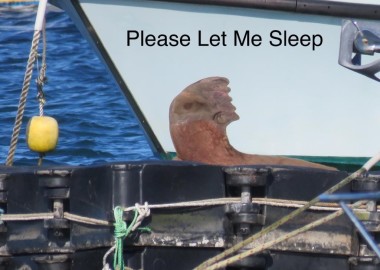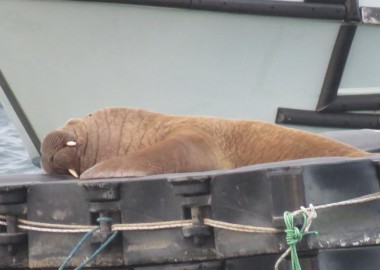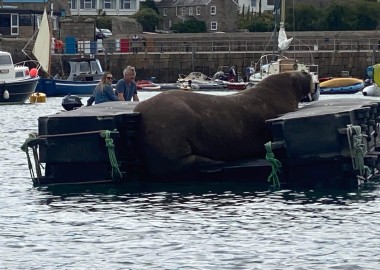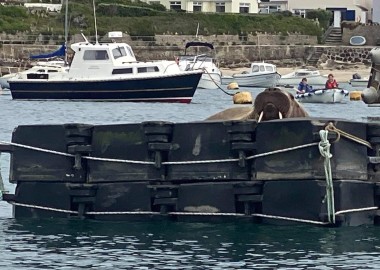Walrus Update!
Answering your questions about the Isles of Scilly’s most unusual visitor – a Walrus – provided by BDMLR, Isles of Scilly Wildlife Trust, Cornwall Seal Group Research Trust and the St Mary’s Harbour Team.
Please Note: This information is accurate at time of writing (12/07/2021) and will be updated as new detail emerges/there is something significant to report. With the welfare of the Walrus, the organisations and individuals involved in monitoring his behaviour, implementing strategies to ensure his safety and limit damage to property in mind, further press interviews will not be given by staff or volunteers at this time; consequently, such requests will be politely declined.
Key Points:
✔️ Boat owners are strongly advised to stop the Walrus from hauling out on boats by blocking access with temporary barriers and obstructions;
✔️ It’s important that the purpose-built pontoon becomes the Walrus’ “safe space”. Something that he returns to, allowing him to rest, gain strength and ultimately leave Scilly to continue his journey home;
✔️ Please do not disturb the Walrus; keep your distance (a minimum of 50-100m);
✔️ When collecting/returning your boat to your moorings do so in a way that minimises disturbance to the Walrus on the pontoon;
✔️ Please do not divert your path, or set your course, to pass the Walrus closely, or move directly towards him.

An important message from a walrus who is repeatedly woken up by people on average once every three minutes

This is a huge animal. If you get close and scare him into the water, he will create a big splash and wave that could cause an accident
What are we doing to help the Isles of Scilly community work around the Walrus
Local island community representatives, statutory agencies from the island / mainland and marine conservation organisations have teamed up to share concerns, advice, expertise, best practice and mitigation actions to minimise all impacts on the walrus, property and livelihoods. British Divers Marine Life Rescue’s Assistant Area Coordinator Lizzi Larbalestier is on the islands to support the Isles of Scilly Wildlife Trust and Harbour Authority to assist in assessing, monitoring and mitigating activity and provide real time updates to dynamically risk assess the situation. This team have the backing and support of all the other organisations involved.
Why is the Walrus here?
We do not know. We know climate change is melting Arctic ice that Walrus’ haul out on. Young male Walrus do wander and explore.
Where has he come from?
Cornwall Seal Group Research Trust’s Sue Sayer has spoken to an Alaskan Walrus expert Lori Quakenbush and whilst Pacific and Atlantic Walrus do vary their behaviours are similar. Lori thinks the Walrus has come from Svalbard (north of Norway – over 3200km from the Isles of Scilly). This means in total, our visiting Walrus has swum an incredible 4000km. This will have used up a lot of energy for this young marine mammal.
What should the Walrus be doing?
Hanging out in close physical contact with other young Walrus around the Svalbard coast. Walrus are highly social creatures and even if there are only 2 Walrus on a beach they will lie touching each other for comfort.
Will he stay in the Isles of Scilly?
Considering the Walrus’ previous mobility and typical walrus behaviour, Lori expects him to move on soon; but he will only be able to do so if the has the energy to make the 3200km journey home. This means he needs to feed up (on invertebrates – clams are his favourite food) and rest peacefully without interruption. If he is continually distracted, he will not gain the weight and energy for a long journey home and will likely remain in Scilly longer. He is feeding well, but his rest is not consistently good. Cornwall Seal Group Research Trust have a great article which explains why giving seals (and this applies to a Walrus too) space is so important …click here to read more!
Why is he in the harbour and not hauling on the uninhabited islands?
We don’t know, but his seemingly gregarious nature means he is most likely seeking company and activity. His initial preference for warm, spongy ribs and the way he curls up into small, enclosed spaces suggests these replicate his missing Walrus companions. Evidence of him mouthing parts of boats could indicate self-soothing. His story is exceptionally sad and invites our compassion.
What is the plan to minimise property damage?
If he approaches vessels, owners should gently deflect him with an oar; boat owners have also been advised to take action and take all possible steps to make their boats more difficult for him to board. We have collectively decided, with the support of the Harbour Office of St Mary’s, that when he hauls out onto the Star of Life ambulance boat, he can be left to rest. If there is a callout, he has been shown to get off the vessel, so not impacting the boat’s ability to serve the community’s emergency needs. Allowing him to remain on the Star of Life reduces potential damage to other vessels which is a key aim of our dynamic risk assessment procedures.
How can we help the Walrus?
BDMLR and the Harbour Authority have constructed a specific customised pontoon replicating his apparent need for physical contact. His scent has been used on it to encourage him to feel safe. The aim is to test to see if he will use it and to encourage him to opt for this rather than the Star of Life (or any other vessel). It has been moored close to the Walrus’ preferred haul out in the hope that he will choose this as a “better option”.
Since the pontoons deployment the Walrus has found it and has now returned to it on a number of occasions in between feeding excursions. The situation is being monitored and it may be possible to re-locate the pontoon outside the harbour area to reduce disturbance and enable him to rest more effectively.

Bespoke pontoon built for the walrus replicating the bodily contact he would seek out on a wild walrus haul out

It is a tight squeeze on a wild walrus haul out like in his pontoon. His sad story invites our compassion
In the meantime all boats owners and water users have been asked to give the Walrus space and refrain from actively moving towards him, but the temptation has proved too strong for many. The Walrus is a highly protected species and disturbance of this nature is a criminal offence. Even a lift of the head means his rest has been interrupted. PLEASE STAY AWAY FROM HIM.
We are aware that the pontoon is moored within an active and busy harbour and are not expecting people to not use their boats. For those moored near where the pontoon/Walrus is when accessing your boats please do so as efficiently as you can, leave your moorings by moving away from where the pontoon is and approach your moorings to pick-up by the same means.
Aren’t we encouraging him to stay by making him at home?
No. Experts have reassured us that it is in his nature to move on. He has shown his ability to move great distances from his visits to Ireland, Wales, Cornwall, France, Spain and now the Isles of Scilly. When he is ready, energy wise, he will move on.
Are we planning to actively drive him out of the Isles of Scilly?
No. Whilst it is in his interests to move north and we want him to head back in the direction of Ireland and beyond, our plan to achieve this is to enable him to become strong enough to make the move for himself.
Is he sick?
His welfare has been assessed by experts and we know his body condition is good and demonstrates he is feeding, so we have hope he can build strength and body mass.
Why can’t we just dart him and air lift him home?
For an animal his size, the drug would take too long to take effect he would be off into the water and likely die. 20% of Walrus are known to die under anaesthesia. He is too big to move realistically and safely. Previous attempts at re-locating other mobile marine species have proved that this option does not work, as relocated animals simply swim the long distances back to where they want to be.
What if an accident happens?
The Walrus has not shown any aggressive behaviour, but he is a young, but still very large, wild animal. We understand that he is interesting, but we strongly advise everyone to keep away from him. As a massive bulky creature, any sudden movement by him when spooked could result in an accident, with serious repercussions for not only the people involved but for him too. If you value the welfare of this amazing creature, please leave him alone and, where possible, keep at least 100 metres between you and him. It is important for the island’s, not just for the tourist economy, to keep the Walrus safe until he can leave.
Where can I find out more?
Click here to link to original web statement
Walrus reference sites
https://arcticwwf.org/species/walrus/ https://www.nationalgeographic.com/animals/mammals/facts/walrus
https://oceanwide-expeditions.com/to-do/wildlife/walrus
https://en.wikipedia.org/wiki/Walrus
Huge thanks to British Divers Marine Life Rescue Assistant Area Coordinator, Lizzi Larbalestier for coordinating monitoring efforts, for providing all these photos using a massive zoom lens, recording activity around the walrus and updating the dynamic risk assessments.
What a huge collaborative achievement in such a short space of time to successfully mitigate risk to people, property and the walrus by deploying some innovative actions with volunteers working alongside the authorities. This will help provide yet more evidence about effective stakeholder engagement for the work we are doing with our generous grant from DEFRA via the National Lottery Heritage Fund called the Green Recovery Challenge Fund.
